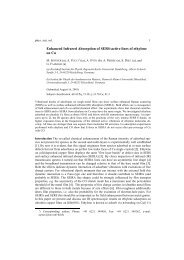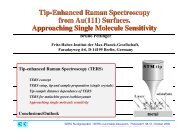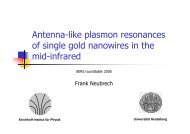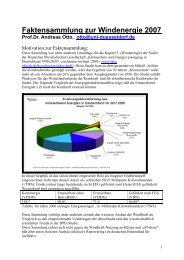From the excitation of surface plasmon polaritons ... - Andreas Otto
From the excitation of surface plasmon polaritons ... - Andreas Otto
From the excitation of surface plasmon polaritons ... - Andreas Otto
Create successful ePaper yourself
Turn your PDF publications into a flip-book with our unique Google optimized e-Paper software.
<strong>From</strong> <strong>the</strong> <strong>excitation</strong> <strong>of</strong> <strong>surface</strong> <strong>plasmon</strong> <strong>polaritons</strong> (SPP’s) by<br />
evanescent waves to „SERS active sites”<br />
<strong>Andreas</strong> <strong>Otto</strong><br />
1) History <strong>of</strong> <strong>plasmon</strong>s, <strong>surface</strong> <strong>plasmon</strong> <strong>polaritons</strong> (SPP) and „<strong>Otto</strong>configuration“<br />
2) Roughness spectrum <strong>of</strong> a smooth silver film obtained by SPP-SPP<br />
scattering.<br />
3) Collecting light from „SPP-cone“ with <strong>the</strong> „Weierstraß-prism“ (WP)<br />
4) Pro<strong>of</strong> <strong>of</strong> <strong>the</strong> <strong>excitation</strong> <strong>of</strong> SPP‘s by „hot electrons“ in metal-insulatormetal<br />
junctions, using <strong>the</strong> WP<br />
5) Using <strong>the</strong> WP in <strong>surface</strong> Raman spectroscopy from single crystal<br />
copper electrodes<br />
6) SERS active sites
Bulk-plasma oscillations (<strong>plasmon</strong>s)<br />
1) Oscillations in ionized gases: Tonks & Langmuir 1929<br />
2) Bulk plasma oscillations in free electron metal:<br />
Pines & Bohm, Phys.Rev.85(1952)338<br />
3) Bulk <strong>plasmon</strong> in Silver, Fröhlich & Pelzer 1955<br />
Proc.Phys.Soc.A68(1955)525<br />
ε(ω) = 0 at<br />
ca.3.75eV
Surface <strong>plasmon</strong> polariton <strong>of</strong> silver<br />
bulk<br />
<strong>plasmon</strong><br />
(Fröhlich,<br />
Pelzer 1955)<br />
hω<br />
( eV )<br />
4<br />
3<br />
2<br />
1<br />
radiative<br />
SPP-dispersion relation<br />
ω/k = c<br />
nonradiative<br />
Surface <strong>plasmon</strong>-polariton <strong>of</strong> plane silver with<br />
phase velocity parallel <strong>surface</strong> < c<br />
Dielectric <strong>the</strong>ory with retardation: „plasmaradiation“<br />
by Ritchie & Eldridge 1962, SPP<br />
dispersion in thin film by <strong>Otto</strong> 1965 (first?)<br />
k parallel<br />
ω εω ( )<br />
( ω)<br />
= ( )<br />
c εω ( ) + 1<br />
Surface Plasmon: Ritchie,<br />
Phys.Rev.106 (1957) 874,<br />
Ferrell and Stern 1958, 1960<br />
unretarded<br />
1/2<br />
k parallel<br />
<strong>surface</strong>
c<br />
α<br />
silver<br />
v phase,parallel <strong>surface</strong> = c/n sin α<br />
c<br />
Problem and idea<br />
phase velocity length <strong>surface</strong><br />
v phase,parallel <strong>surface</strong> = c/sin α >c<br />
c c<br />
α ≥ α<br />
total reflection: n sin α > 1 evanescent field with v phase,parallel <strong>surface</strong> < c<br />
c/n<br />
total reflection<br />
c/n<br />
PUT <strong>the</strong> silver sample in about a wavelength<br />
distance BELOW <strong>the</strong> prism!
The realization (1968)<br />
A. <strong>Otto</strong>, Excitation <strong>of</strong> nonradiative <strong>surface</strong> plasma waves in silver by <strong>the</strong> method <strong>of</strong> frustrated<br />
total reflection, Z. Physik 216 (1968) 398, download from http://fkphy.uni-duesseldorf.de<br />
measuring D by intererence<br />
fringes <strong>of</strong> white light<br />
gap width d ~λ<br />
Want to know more about<br />
history, priority, who<br />
invented and introduced <strong>the</strong><br />
names „X-configuration“?<br />
Look for<br />
www.fkphy.<br />
uni-duesseldorf.de/<br />
lecturexiamen/LectureI<br />
SPP resonance only observed for p-polarized light (equivalent to TH polarization)
Experimental dispersion<br />
ω<br />
k( hω)=<br />
sinα<br />
c<br />
minimum <strong>of</strong> reflectivity
In 1968, <strong>the</strong> sensitivity <strong>of</strong> <strong>the</strong> ATR – SPP resonance was clear,<br />
but real <strong>surface</strong> diagnostic needs were not known, at least to me.<br />
error bar<br />
+2nm AgS<br />
+1nm AgS<br />
calculated<br />
experiment
2) Roughness spectrum <strong>of</strong> a smooth<br />
silver film obtained by SPP-SPP<br />
scattering
k = kSPP<br />
out<br />
Fluid prism (refractive<br />
index <strong>of</strong> BK7 glass)<br />
in<br />
ω<br />
k = n<br />
c<br />
k<br />
=<br />
ω<br />
c<br />
k x<br />
Scattered<br />
intensity<br />
Laser<br />
in<br />
Quantitative measurement <strong>of</strong> <strong>the</strong><br />
roughness spectrum <strong>of</strong> silver films,<br />
J. Bodesheim, A. <strong>Otto</strong> Surf. Sci. 45 (1974) 441<br />
SPP(in) – SPP(out) –<br />
scattering<br />
with „fluid-prism“
oughness spectrum <strong>of</strong> a „smooth“ silver film<br />
without ATR-prism<br />
with ATR-prism,<br />
perpendicular<br />
incidence<br />
from SPP – SPP<br />
scattering
3) Collecting light from „SPP-cone“<br />
with <strong>the</strong><br />
„Weierstraß-prism“ (WP)
Invention <strong>of</strong> <strong>the</strong> „Weierstraß-prism“ : Integration over all emitted SPP‘s<br />
from an emitting point<br />
k = kSPP<br />
out<br />
out<br />
ω<br />
k = n<br />
c<br />
k<br />
ω<br />
=<br />
c<br />
k x<br />
W. Wittke, A. Hatta, A. <strong>Otto</strong><br />
Efficient use <strong>of</strong> <strong>the</strong> <strong>surface</strong> <strong>plasmon</strong> polariton resonance in light scattering from adsorbates.<br />
Applied Physics A 48 (1989) 289-294
Adjusting <strong>the</strong> gap sample-Weierstraßprism<br />
R=1 d=2λ L R=0.94 d=3/2 λ L<br />
gap modes<br />
R=0.71 d=5/4 λ L R=0.35 d=λ L<br />
Peter Bor<strong>the</strong>n, Diplomarbeit Düsseldorf 1988<br />
SPP<br />
R=0.45 d=3/4 λ L<br />
R=0.81 d< 1/2 λ L<br />
R=0.61 d=1/2 λ L
4) Pro<strong>of</strong> <strong>of</strong> <strong>the</strong> <strong>excitation</strong> <strong>of</strong> SPP‘s by<br />
„hot electrons“ in metal-insulator-<br />
metal junctions, using <strong>the</strong> WP
Ag<br />
hot<br />
electrons<br />
<strong>excitation</strong> <strong>of</strong><br />
slow modes?<br />
<strong>excitation</strong><br />
<strong>of</strong> SPP‘s ?<br />
Reversed bias:<br />
No <strong>excitation</strong><br />
<strong>of</strong> SPP‘s ?<br />
Light emission from<br />
Al/AlOx/Ag tunnelling<br />
junctions<br />
D. Diesing, G. Kritzler, A. <strong>Otto</strong>, Surface reactions <strong>of</strong> hot<br />
electrons at metal-liquid interfaces, in Solid Liquid<br />
Interfaces, Macroscopic Phenomena and Microscopic<br />
Understanding, eds. S. Thurgate and K. Wandelt,<br />
Topic in Applied Physics 85, p.365-421 Springer 2003<br />
d
Inset: integrated normalized emission<br />
as function <strong>of</strong> d<br />
200nm<br />
400 nm<br />
1000nm<br />
2000nm<br />
Diesing, G. Kritzler, A. <strong>Otto</strong><br />
D. Surface reactions <strong>of</strong> hot electrons at metal-liquid interfaces<br />
Topic in Applied Physics 85, p.365-421 Springer 2003<br />
Reversed bias: No light,<br />
no <strong>excitation</strong> <strong>of</strong> SPP‘s !<br />
Pro<strong>of</strong> <strong>of</strong> hot electron – SPP<br />
mechanism
5) Using <strong>the</strong> Weierstraß-prism in<br />
<strong>surface</strong> Raman spectroscopy from<br />
single crystal copper electrodes
Advantage <strong>of</strong> „<strong>Otto</strong> –configuration“, when using flat single crystals <strong>of</strong> different<br />
orientations: Variation <strong>of</strong> gap width, no excessive heating <strong>of</strong> <strong>the</strong> sample<br />
A. Bruckbauer, A. <strong>Otto</strong>,, J. Raman Spectrosc., 29 (1998) 665-672<br />
Raman<br />
light<br />
0.01 M pyridine +<br />
0.1M KClO 4<br />
aqueous electrolyte<br />
Laser beam<br />
Hg/Hg 2 SO 4<br />
reference<br />
ring breathing Raman band <strong>of</strong><br />
pyridine at optimal electrode<br />
potential
Reversible potential dependance <strong>of</strong> SERS <strong>of</strong> pyridine at Cu electrodes <strong>of</strong> different<br />
crystallographic orientation<br />
Cu-electrode potential<br />
electrolyte: 0.01 M pyridine in 0.1<br />
M KClO 4, (Hg/Hg 2 SO 4 ) reference electrode<br />
Capacity measurements: pyridine stays<br />
adsorbed at all electrode potentials E.<br />
The dependence <strong>of</strong> intensity on potential<br />
reflects tuning in and out <strong>of</strong> <strong>the</strong> transient<br />
electron transfer resonance.<br />
(metal-adsobate) (metal + -adsorbate - )<br />
(Socalled „first layer chemical effect“ in<br />
SERS)
SERS <strong>of</strong> pyridine at Cu electrodes originates at defects (SERS active sites)<br />
Cu(110) vicinal at E = -1000mV<br />
Cu(110) vicinal at E=-500 mV<br />
Cu(110) vicinal at E=-1700 mV<br />
Cu(111) at E=-1100 mV<br />
SERS <strong>of</strong> pyridine on Cu<br />
films deposited at T substrate<br />
120K<br />
240K<br />
300K<br />
pyr. at defects pyridine at Cu(111) facets<br />
Electromagnetic<br />
enhancement by<br />
SPP resonance is<br />
not enough to<br />
observe pyridine at<br />
atomic smooth<br />
facets
Concentration <strong>of</strong> <strong>surface</strong> defects is unknown in this experiment<br />
83<br />
40<br />
19<br />
3<br />
Average enhancement <strong>of</strong> SERS <strong>of</strong> pyridine<br />
at Cu electrodes <strong>of</strong> different<br />
crystallographic orientation<br />
electrolyte: 0.01 M pyridine in 0.1<br />
M KClO 4, (Hg/Hg 2 SO 4 ) reference electrode<br />
Average enhancement with respect to<br />
pyridine in <strong>the</strong> liquid gap (assuming<br />
SERS originates from all adsorbed<br />
pyridine molecules, ra<strong>the</strong>r than only<br />
from species adsorbed at defects)
6) SERS active sites
pyridine on silver in<br />
Ultra-High-Vacuum,<br />
influence <strong>of</strong> atomic scale<br />
roughness<br />
Ü.Ertürk,D.Gherban, A.<strong>Otto</strong>, Surf.Sci.203, 554(1988)<br />
(a) Top: Raman spectrum <strong>of</strong> a<br />
silver film, deposited at room<br />
temperature, exposed at about<br />
40 K to 1 L <strong>of</strong> pyridine in <strong>the</strong><br />
range <strong>of</strong> <strong>the</strong> C-C breathing mode,<br />
1 W, integration time 2000 s.<br />
Bottom: Raman spectrum <strong>of</strong> liquid<br />
pyridine. (b) Raman spectra <strong>of</strong> <strong>the</strong><br />
sample described in (a) for<br />
<strong>the</strong> indicated average thickness<br />
d cold <strong>of</strong> additional silver deposited<br />
on top at about 40 K. 1 W,<br />
integration times 800,400, 400,400<br />
s.<br />
SERS active sites<br />
normal sites
SERS intensity and<br />
<strong>the</strong>rmo-desorptionspectroscopy<br />
<strong>of</strong> CO<br />
on cold-deposited Ag<br />
exposures<br />
desorption from defects<br />
CO-stretch<br />
SERSintensity<br />
W. Akemann, A. <strong>Otto</strong><br />
Vibrational modes <strong>of</strong> CO adsorbed to disordered copper<br />
films investigated with Raman spectroscopy.<br />
J. Raman Spectrosc. 22 (1991) 797-803<br />
Thermal<br />
desorption<br />
desorption temperature (K)<br />
SERS only from<br />
a minority <strong>of</strong><br />
sites, where CO<br />
is most tighly<br />
bound and settles<br />
first<br />
multilayer desorption
STM on<br />
Cu(211)<br />
Ball model <strong>of</strong> <strong>the</strong> Cu(211)<br />
<strong>surface</strong>. The distance between<br />
intrinsic steps is 0.625nm.<br />
Horizontal chains from left to<br />
right are along <strong>the</strong> (0, -1, 1)<br />
direction. Copper atoms in <strong>the</strong><br />
step edge are labeled A, at <strong>the</strong><br />
kink site: B<br />
CO binds preferentially<br />
to kink sites
Clean Cu(211), CO settles first at kink sites<br />
A. <strong>Otto</strong>,<br />
M. Lust,<br />
A. Pucci,<br />
G. Meyer<br />
Proceedings<br />
<strong>of</strong> SERRS<br />
2006, in press<br />
in<br />
Canadian<br />
Journal <strong>of</strong><br />
Analytical<br />
Sciences and<br />
Spectroscopy<br />
“SERS active<br />
sites“, facts and<br />
open questions”
A.<strong>Otto</strong>, M.Futamata, Electronic Mechanisms <strong>of</strong> SERS, in Surface enhanced Raman scattering, physics and applications,<br />
eds K.Kneipp, M.Moskovits, H.Kneipp, Topics inApplied Physics 103 (2006)147-182<br />
No CT-SERS at smooth <strong>surface</strong>s<br />
resonant Raman effect <strong>of</strong><br />
<strong>the</strong> complex by internal<br />
charge transfer
SERS active sites = sites, where electrons are trapped for some fs<br />
A. <strong>Otto</strong>, The „chemical“ (electronic) contribution to SERS, J. Raman Spectr. 36 (2005)497<br />
acts for a short time <strong>of</strong> about 5fs as an isolated metalmolecule<br />
complex („hole does not run away“). Internal<br />
resonance Raman effect by charge transfer for molecules<br />
with π* orbital becomes possible. There is no „first layer<br />
SERS-effect“ at a smooth <strong>surface</strong>.
Acknowledgments to my collaborators 1977-2002<br />
visitors, now at SPP3: Lopez-Rios, Futamata<br />
to Pr<strong>of</strong>. Annemarie Pucci and her people (e.g. Lust, Sin<strong>the</strong>r, Priebe),<br />
M.Futamata (Tsukuba) and G.Meyer (IBM Zürich) and my first<br />
„SPP-students“ in München (1970-1974): Sohler, Bodesheim, Huber.
Merci á<br />
Alain Dereux








